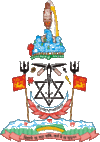Hridayendra Shah
| Hridayendra Bir Bikram Shah | |||||
|---|---|---|---|---|---|
| Born | 30 July 2002 Narayanhity Palace, Kathmandu, Nepal | ||||
| |||||
| Dynasty | Shah dynasty | ||||
| Father | Paras Bir Bikram Shah Dev | ||||
| Mother | Himani Rajya Lakshmi Devi Shah, Crown Princess of Nepal | ||||
| Religion | Hinduism | ||||
| Education | Suffolk University | ||||
| Nepalese royal family |
|---|
 |
|
Descendants of King Mahendra:
Descendants of King Tribhuvan: Princess Trilokya |
Hridayendra Shah (Nepali: हृदयेन्द्र शाह) (born 30 July 2002) is a member of the former Nepalese Royal Family and was the second in line to Nepal's royal throne. The monarchy was officially abolished on 28 May 2008.[1] Until the abolition of the monarchy he was known in Nepal by the title Nava Yuvaraj.
Nava Yuvaraj
[edit]Prince Hridayendra was born at 12:49 pm in the Narayanhity Royal Palace in Kathmandu to Paras Bir Bikram Shah Dev, Crown Prince of Nepal and Crown Princess Himani Rajya Lakshmi Devi Shah.[2]
His grandfather Gyanendra Bir Bikram Shah Dev is the deposed king of Nepal and his grandmother is deposed queen Komal Rajya Lakshmi Devi Shah, a member of the Rana dynasty. Through his mother he is descended from the Indian princely family of Sikar, which belongs to the Shekhawat clan. Following Hindu custom he was officially named Hridayendra Bir Bikram Shah Dev in a ceremony at the Narayanhity Royal Palace eleven days after his birth.[3]
In Hinduism there are a number of stages to groom a future king. Hridayendra received the traditional rice feeding ceremony (Annaprasan ceremony) at the Narayanhity Royal Palace six months after his birth. The ceremony was carried out in accordance with Vedic tradition. He was fed rice by his mother, and then by other members of the Royal Family, during the ceremony. He was offered a gold coin by Prime Minister Lokendra Bahadur Chand and other officials following another traditional feature of the ceremony. Later, Hridayendra made his first public appearance in a chariot procession and was taken to holy sites in old Kathmandu, where worship and rituals were conducted. The prime minister acted as his guardian during this stage of the ceremony, and carried the prince around the temples to symbolise the bond between the people and the monarchy.[4]
Place in line of succession
[edit]Hridayendra was second in the line of succession to the Nepalese throne. In August 2006, before the monarchy was suspended, the Nepalese government adopted a bill to replace the Agnatic succession law with equal primogeniture. The House of Representatives subsequently approved the bill. Had the bill become law, Prince Hridayendra would not have been relegated to third in the line of succession, his older sister Princess Purnika being elevated to second, because a clause of the law stipulated that living dynasts would not be deprived of their position or titles, the new provisions going into effect for those born subsequent to the change in succession order.[5]
In February 2007, there was speculation in Nepal that Hridayendra's father and grandfather would make way for him to take the throne.[6] In July 2007, the Nepalese Prime Minister Girija Prasad Koirala repeated calls for the King and Crown Prince to abdicate in favour of Hridayendra[7] though this was rejected by the Maoists.[8]
Abolition of monarchy
[edit]On 24 December 2007, it was announced that Nepal would abolish the monarchy in 2008 after the Constituent Assembly elections.[9] On 28 May 2008, the monarchy was officially abolished, replaced by an interim secular federal republic.[1]
Prior to the abolition of the monarchy, Hridayendra attended Rupy's International School in Kathmandu with his sisters deposed Princesses Purnika and Kritika.[10] In July 2008, Hridayendra left Nepal with his mother and sisters to move to Singapore to join his father who had been making arrangements for the family to live in the country.[11][12]
References
[edit]- ^ a b "Nepal votes to abolish monarchy". BBC. 28 May 2008. Retrieved 29 May 2008.
- ^ "Nepalese crown princess gives birth". Asian Political News. 5 August 2002. Archived from the original on 31 December 2007. Retrieved 31 July 2007.
- ^ Pradhan, Suman (10 August 2002). "New heir heralds public acceptance of Nepal royals". The Times of India. India. Retrieved 31 July 2007.
- ^ Poudel, Keshab (17 January 2003). "Ritual of Harmony". Nepalnews.com. Archived from the original on 27 September 2007. Retrieved 31 July 2007.
- ^ "Days in Nepali History" (PDF). Nepali Aawaz. p. 3. Archived from the original (PDF) on 9 August 2007. Retrieved 31 July 2007.
- ^ "King to quit Nepal?". India enews. 7 February 2007. Archived from the original on 9 February 2007. Retrieved 31 July 2007.
- ^ "Nepal baby prince's baptism by fire". The Times of India. India. 20 June 2007. Archived from the original on 17 October 2012. Retrieved 31 July 2007.
- ^ Page, Jeremy (6 July 2007). "Envoys snub king's birthday party". The Times. London. Retrieved 19 March 2008.[dead link]
- ^ "Nepalese monarchy to be abolished". BBC. 24 December 2007. Retrieved 25 December 2007.
- ^ Patrika, Naya (19 June 2007). "Little King". Nepali Times. Retrieved 31 July 2007.
- ^ "Nepal ex-prince's family leaves". BBC. 17 July 2008. Retrieved 17 August 2008.
- ^ "Ex-princess Himani leaves for Singapore". Kantipur.com. 17 July 2008. Retrieved 17 August 2008.[permanent dead link]
